This page and the others in this series endeavour to document the diesel years at Derby Locomotive Works.
Two facets are explored, a look at the 1,010 diesel locomotives built at Derby Locomotive Works and diesel locomotives from other Workshops and builders that visited the Workshops from time to time.

A breakdown of the 1,010 diesel locomotives by type built at Derby Locomotive Works between 1932 & 1967 are:
Shunters: 599
10000/01: 2
Fell Loco: 1
Class 24: 77
Class 25: 226
Class 44: 10
Class 45: 39
Class 46: 56
(The numerical listing of the 1,010 locomotives is based on contemporary reports and hopefully is accurate, though where multiple production lines were running, particularly 1958 - 1960 the list is open to dispute as to which locomotive fits into each slot on the overall list).
![]()
The Shunters from the 1930s & 1940s
Diesel hydraulic 0-6-0 1831
By the time the LMSR took a serious interest in the possibility of introducing diesel traction into its fleet the basics of the diesel engine coupled to several types of transmission had been well explored in a number of countries, some combinations leading the way in the evolution of the diesel locomotive, others proving to be unsuccessful. The LMSR's pioneer fell into the latter category.
The LMSR took an economical approach to the situation by using the frames and wheels of ex-Midland Railway Class 1F 0-6-0 tank 1831 built at Vulcan Foundry, Newton-le-Willows in 1892. The approval for the conversion had occurred late in 1931, at which time a Davey Paxman engine was chosen to power the locomotive, utilising a hydraulic transmission from Haslam & Newton, Derby. This was another cost saving measure, the capital cost of electrical transmission equipment would have rendered the project uneconomic.
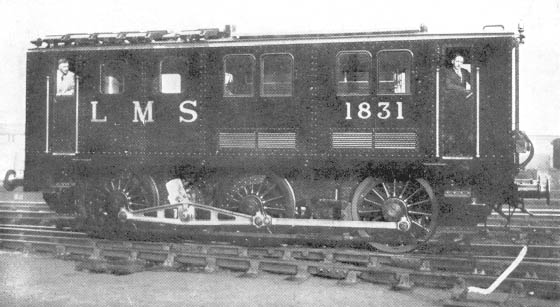
Released from Derby Works during November 1932, the locomotive was delivered to Euston for inspection prior to returning to Derby for testing in general shunting locally and at Toton. Various transmssion failures led to modifications and improvements. It was the destruction of the hydraulic transmission sometime late in 1936 that led to the storing of the locomotive at Derby, although official withdrawal did not take place until September 23rd 1939. World War II brought a new lease of life to 1831, not as a shunting locomotive, but as a mobile generator. It moved to Crewe for rebuilding in February 1940 and was released from there during November 1940. In its rebuild, the locomotive, now renumbered MPU3 kept its Davey Paxman engine, but now direct coupled to an electric generator. It spent some time at Coventry in 1940/41 before returning to Crewe, later being seen at Derby between late 1945 to early 1948. During 1949 it was noted at Crewe and appeared to remain there until broken up at Crewe Works in the latter half of 1955.
Diesel engine: Davey Paxman & Co, (Colchester) 6cyl 4 stroke 400bhp @ 750rpm.
Transmission: Haslam & Newton, Derby; hydraulic.
Weight: empty - 44t 15cwt; working order - 46t 2cwt
Wheelbase: 15ft 8in
Wheel diameter: 4ft 7in
Length over buffers:30ft 3.75in
Height: 12ft 9in
Width: 8ft 7.5in
Tractive Effort: 20,000lb to 22,400lb
Maximum Speed: 25mph
Fuel capacity: 140 gallons
Total Conversion Cost: GBP7,514.77 - initial costs & improvements.
![]()
Whilst not a success 1831 provided the LMSR with valuable information. Between 1932 & 1934 the LMSR had also received for testing and evalution nine diesel shunting locomotives from private builders, none were constructed at Derby. Only one featured an electric transmission, which in light of it being heavier than the rest (an 0-6-0 rather than an 0-4-0) proved to be the direction in which the LMSR would proceed. This locomotive from Armstrong Whitworth powered by a Sulzer engine with electrical equipment by Laurence Scott & Electromotors was closely followed by a prototype 300hp shunting locomotive from R&W Hawthorn Leslie Co Ltd utilising an English Electric engine and transmission. These two machines would lay down the general characteristics of future shunting locomotives to be built at Derby.
The success of these two machines led to further orders of ten from each manufacturer, delivered in 1935 & 1936. None were built at Derby but all saw service on the LMSR.
These twenty machines further re-inforced the thinking of the LMSR authorities that the 350hp diesel electric shunter was the way forward. The following table provides details of the locomotives built at Derby that were derived from the Armstrong Whitworth & English Electric designs.
The Great Western Railway also sampled the offerings from Hawthorne Leslie, ordering a single English Electric powered prototype in 1936, it would be numbered No.2 by the GWR and later became 15100. The GWR would not order and more similar diesel shunters until after World War Two.
During 1936 - 1937 the Southern Railway workshops at Ashford built three 0-6-0 shunters, designed by Richard Maunsell and powered by the English Electric 350hp engine. They were numbered Nos.1-3, later 15201 - 15203. In 1938 a further eight locomotives were ordered, but these were delayed until after Nationalisation and the order increased to 26 (Nos.15211 - 15236).
The LNER did not venture into the building of the 0-6-0 diesel electric shunters until 1944.
![]()
| Summary of shunting locomotives ordered by the LMSR 1936 - 1947 | ||||
| Order #, date & quantity | Initial Cost per Loco | Delivery | Numbers | Retired |
| 458 & 486; July 1936; 20 | GBP6,600 | 5/39 - 7/40 | LMS 7080 - 7099, BR 12003 - 12022 | 1966 - 1967 | 1333 & 1334; June 1939; 20 | GBP7,200 | 10/41 - 6/42 | WD 49 - 58, LMS 7110 - 7119, BR 12023 - 12032 | 1964 - 1994 | Dec 1940 - 100 | GBP9,100 | Order cancelled | - | - | ?? - 20 | ?? | Order cancelled | - | - | 3239 & 3240; ??; 20 | ?? | 5/44 - 12/45 | WD260 - 273 & LMS 7120 - 7125, BR 12033 - 12038 | 1956 - 1978 | ?? - 20 | ?? | Order cancelled | WD280 - 299 | - | 1705; Dec 1945; 10 | GBP10,000 | 8/47 - 12/48 | LMS 7126 - 7135, BR 12039 - 12048 | 1968 - 1969 | 2437; Oct 1946; 10 | GBP11,400 | 12/48 - 10/49 | (LMS 7136 - 7145) BR 12049 - 12058 | 1969 - 1971 | 3285; Oct 1947; 10 | GBP14,400 | 11/49 - 3/50 | (LMS 7146 - 7155) BR 12059 - 12068 | 1967 - 1972 |
Diesel electric 0-6-0 LMS 7080 - 7119 (Order #'s 458, 486, 1333 & 1334)
(BR numbers 12003 - 12032)
The first orders built at Derby were a compromise, featuring the English Electric engine and transmission but using the single large traction motor mounted above the frames in the engine compartment and driving the wheels through a jackshaft arrangement, as initially featured in the 1933 Armstrong Whitworth design. (The two axle hung self-ventilated nose-suspended traction motors driving through a single reduction gearing which featured under the English Electric designs had suffered from serious overheating.) Hence the flawed jackshaft drive would remain until the engineering difficulties in using forced ventilation and double reduction gearing on the axle hung motors had been overcome.
It was also perhaps unfortunate that Armstrong Whitworth had shut down their Rail Traction Division by this time. However the internal layout remained similar to the Armstrong Whitworth design with the exception of the position of the electrical control cubicle, which now formed the driver's desk.
Three of the first order were fitted with vacuum exhausters, for the brake testing of assembled goods trains, this equipment was later removed. The second batch were fitted with a belt driven auxiliary generator for battery charging. In the earlier batch this had been done by the generator when idling. As these machines were to spend much time hump shunting they were fitted with two speedometers, the normal one showings 0-20mph, the second one reading 0-2mph. It was calibrated in 0.02mph divisions, a vernier control handle on the cab desk permitted fine adjustment of the locomotive speed.
The first twenty (7080 - 7099) were used at Toton, Willesden & Crewe South. A couple were borrowed by the War Department (WD) starting in 1941. Of the second batch (7100 - 7119) requests/demands were placed upon the LMSR to release them to the WD as part of the continued war effort. This proved problematic for the LMSR as the success of the existing diesel electric shunters, the increased demands from the wartime traffic and the additional manpower needed when diesel turns reverted back to steam shunters came at a time when the railways were being asked to do more than ever with ever diminishing resources.
The WD required twenty two locomotives, six came from the 1935/36 RS Hawthorn Leslie built batch, ten (7100 - 7109) were diverted to the WD after completion at Derby and were renumbered 49 - 58. The final six wanted by the WD (7110 - 7115), after much pleading from the LMSR were released for use at Kingmoor. 7116 - 7119 went directly to service at Crewe South, Willesden & Toton, the Kingmoor six later being moved to Toton!
As one might imagine the service histories for the LMSR machines were mundane, after Nationalisation they were renumbered 12003 - 12032 and all remained in service until 1964 when 12030 was the first withdrawn. By the end of 1967 all the BR machines were out of service & retired. None reached into industrial service or preservation, by the end of 1968 all had been broken up. They were outlived by the ten WD machines (LMSR 7100 - 7109, then WD 49 - 58). Some of the Egyptian examples lasted until 1974, whilst certain of the Italian machines (7103/05/06/09) were rebuilt in the 1980's and worked at least into the mid 1990's with a track maintenance contractor in northern Italy. By 1999 7106 was still in service with the privately owned La Ferroviara Italiana railway. Remarkably its remaining sister 7103 reached preservation at the Museo Ferroviairio Piemontese in Turin.
Three of the group were scrapped at Derby Works; 12011, 12029 & 12030.
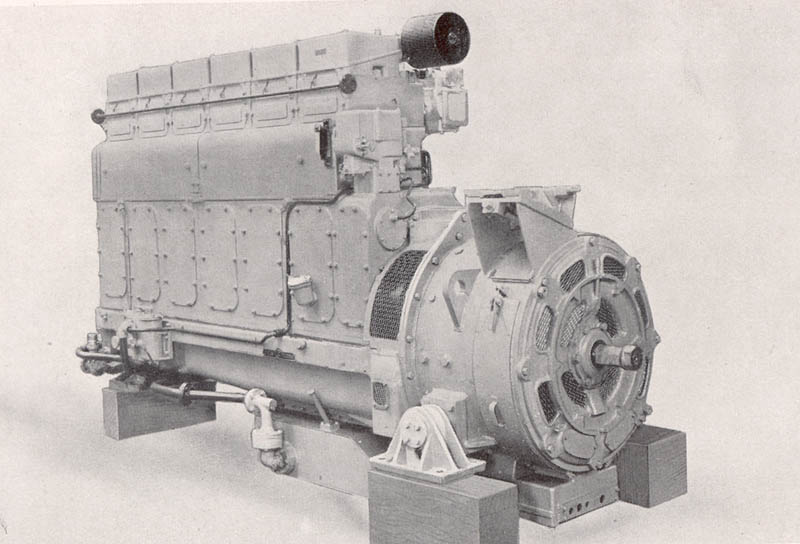
Two cancelled orders
Late in 1940 authorisation had been recieved to build a further one hundred shunting locomotives, the CME stressing the known inherent advantages of the existing diesel electric shunters over their steam counterparts. A further twenty were also ordered to replace the 1935/36 batches which had been commandeered by the War Department. Both orders were cancelled due to the problems created by the escalation of World War Two.
![]()
Diesel electric 0-6-0 WD 260 - 273, LMS 7120 - 7125 (Order #'s 3239 & 3240)
(BR numbers 12033 - 12038)
In 1940 LMS 7074 became the guinea pig for the engineers to solve the problem of overheating in the English Electric design. Low speed and high current conditions found in regular & hump shunting produced large quantities of heat that was not quickly dissipated by the armature mounted fans. Reducing the locomotive's maximum speed from 30mph to 20mph allowed the fitting of double reduction gearing, and by installing forced ventilation to the motors solved the problem of overheating.
This modification was now featured in this and all following orders for what would soon become British Railways standard shunter. The layout remained very similar to earlier builds except for the better distribution of the internal components allowing for a reduction in weight of eight tons, these machines weighed 47tons 5cwt.
Visually this build would be the style that later would be easily recogniseable as the BR Class 08 standard 0-6-0 shunting locomotive.
This order was placed by the Ministry of Supply, fourteen were delivered to the War Department prior to the end of the Second World War, with the war ended the remaining six passed to the LMSR. Several of the WD machines saw brief service on the LMSR at Toton, possibly as a breaking in turn whilst ex-works from Derby, for the remainder of their WD careers the first nine spent much time in France, Holland & Belgium, the remainder seeing mixed service overseas and within the United Kingdom. Ten locomotives were purchased by the Dutch Railways in 1946 and remained in service into the 1970's. One ended its days in France, another being purchased by the Danish Railways. Those remaining in the UK worked out their time at various WD locations.
Again the WD operated locomotives outlived their BR counterparts, 12033 - 12038 were all withdrawn by 1969 & broken up by the middle of 1971, whilst the others lasted into the mid 1970's, either in the UK or overseas.
One early WD retirement was WD 877 (70271) which collided head on with Stanier 8F WD 512 (later BR 48775) on the Longmoor Military Railway (LMR) on October 13th 1956. Six soldiers were killed and twelve injured in the first fatal accident on the LMR. The diesel shunter was scrapped in 1957.
Two of this order are preserved, WD 70269, after many years of operation in Holland became part of the Dutch National Collection during 1995. And WD 70272 (later AD601) after retirement in 1980 was preserved on the Lakeside & Haverthwaite Railway, Cumbria, UK.
At about the same time these locomotives were beng built, the LNER workshops at Doncaster had taken their first foray in the 0-6-0 shunter arena by constructing four locomotives powered by the English Electric 350hp engine. These were numbered Nos.8000 - 8003 (later 15000 - 15003). A fifth locomotive was built but powered by a 360hp Petter engine, this was delivered after Nationalisation, numbered 15004. Additionally in 1945 the GWR ordered six more English Electric powered 0-6-0 shunters, these would not be built until after Nationalisation, numbered 15101 - 15106. A seventh similar locomotive for the GWR was built with a Petter engine, numbered 15107.
![]()
One cancelled order
A second order placed by the Ministry of Supply to follow on from the above order was cancelled due to the cessation of hostilities.
![]()
Diesel electric 0-6-0 LMS 7126 - 7155 (Order #'s 1705, 2437 & 3285)
(BR numbers 12039 - 12068)
These were the last three orders placed under the auspices of the LMSR. However only four of the locomotives were delivered prior to Nationalisation (7126 - 7129), two - 7130 & 7131 were delivered in 1948 retaining the LMSR numbers, whilst the first to receive the new numbering was 12045 (7132). 7129 was the last diesel shunter to be built for the LMSR.
The majority of this class lasted into the early 1970's, about half a dozen after withdrawal from BR went into industrial service, mostly with the National Coal Board.
Only one of this batch ended their days at Derby Works, blue liveried 'D' prefixed 12062, broken up in December 1971.
![]()
1947
Diesel electric Co-Co 10000 & 10001
Fell locomotive 10100
Since the LMSR had acquired much experience in the field of diesel electric shunting locomotives, it was only logical that they would eventually venture into the arena of building mainline passenger locomotives. The onset of Nationalisation spurred the authorities to put into traffic a mainline passenger locomotive prior to the disappearance of the 'Big Four' into 'British Railways'. Thus in May 1946 representatives from English Electric & the LMSR reached agreement on the construction of two 1,600hp six axle diesel electric locomotives.
Another project received approval just prior to Nationalisation, in October 1947 an agreement between Davey Paxman & Co, Shell Refining & Marketing Co & Lt-Col LFR Fell led to the eventual construction of the infamous 10100 Fell locomotive, with Derby Locomotive Works as the main contractor.
Of the above three locomotives only 10000 was completed prior to December 31st 1947, 10001 was still under construction and the Fell locomotive would not have the frames laid until March 1949.
Such was the speed of the project in the building of the LMSR Twins that 10000 was completed in seven months, being rolled out of the Works early in December 1947, allowing the locomotive to carry LMS on its sides. It was left to LMS Chief Mechanical Engineer Mr H G Ivatt to drive 10000 out of the paintshop on December 8th 1947. It would be put into traffic five days later.
Also under construction at Derby during 1947 were 0-6-0 shunters LMS 7126 - 7135 (later British Railways 12039 - 12048), this order would see delivery completed in December 1948.
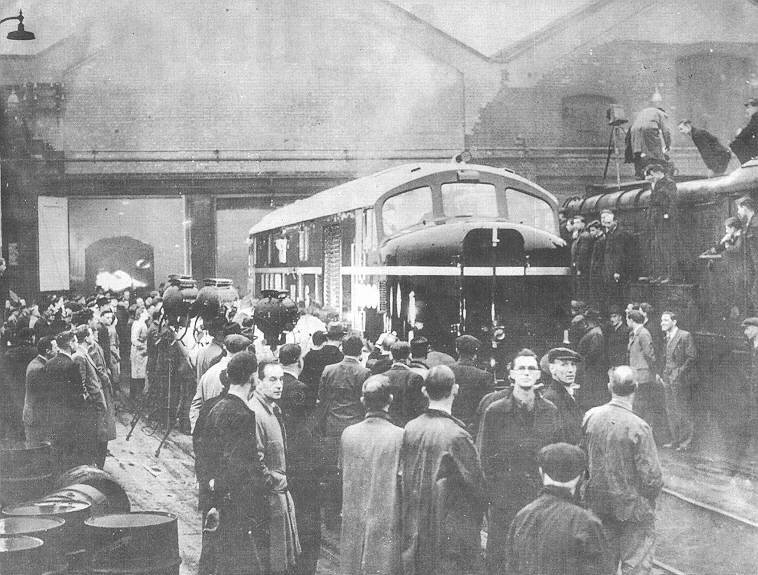
![]()
1948
After several weeks of test running 10000 returned to Derby Works for modifications before going back into traffic during the second week of February. 10000 would return to the Works during July for examination.
The second Twin, 10001 entered service during the first week of July 1947.
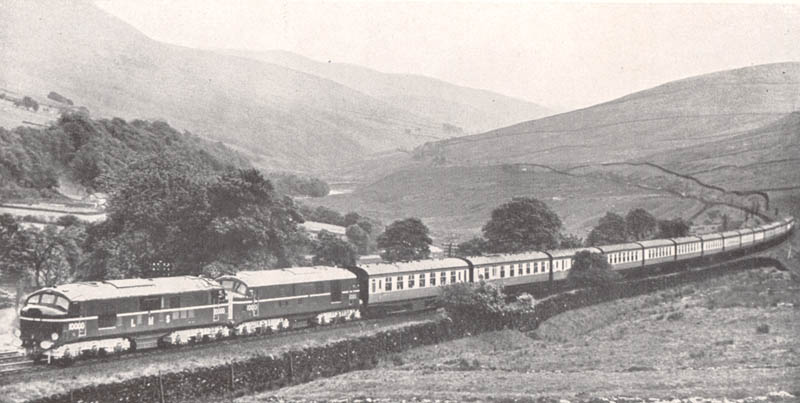
Under construction late in 1948 were 0-6-0 shunters 12049 - 12058, the first of the order would be delivered in December 1948, the last in October 1949.
![]()
1949
In the first quarter of 1949 work commenced very slowly on Fell locomotive 10100.
10001 spent much of May 1949 in Derby Works undergoing overhaul. It would be back at the Works during December spending several months there.
Late in 1949 Derby Works was working on 0-6-0 shunters 12059 - 12068, the first of this order would be delivered in November 1949, the last in March 1950.
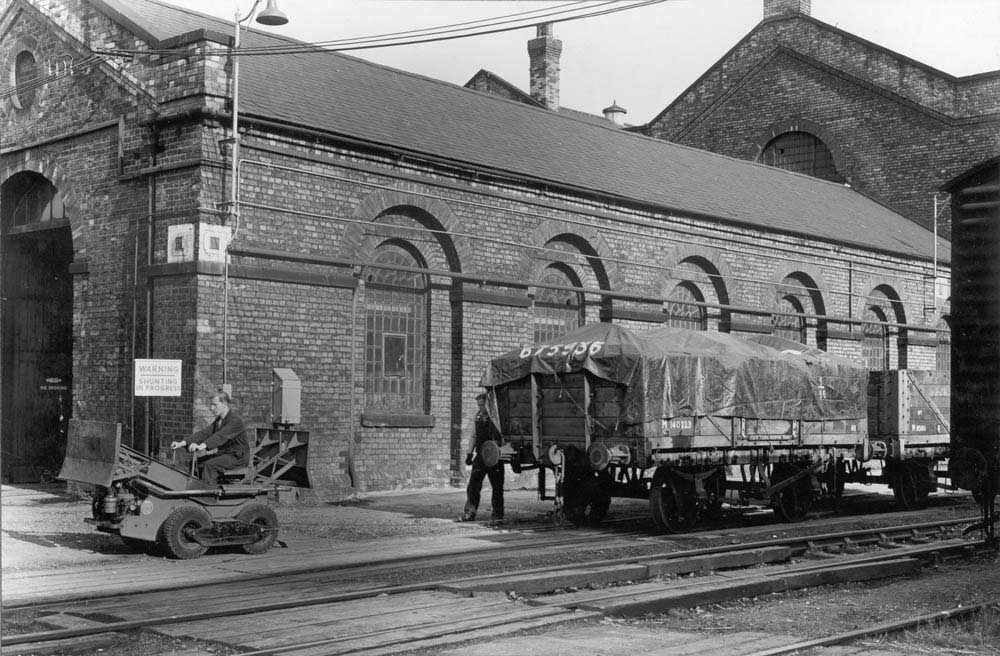
![]()
Page added September 15th 2019.
Principal Sources Used in no particular order:
Diesel & Electric Disposal; A Butlin, Coorlea Publishing 1987.
Diesel Locomotives of the LMS; JWP Rowledge, The Oakwood Press 1975.
LMS Diesel Locomotives & Railcars; EV Richards, RCTS 1996.
BR Locomotives & Other Motive Power (Combined Volume); Ian Allan - various years.
Page update January 19th 2004
Derby Works 1950 - 1959
Derby Works 1960 - 1969
Derby Works 1970 - 1975
Derby Works 1976 - 1980
Derby Works 1981 - 1983
Derby Works 1984 - 2007